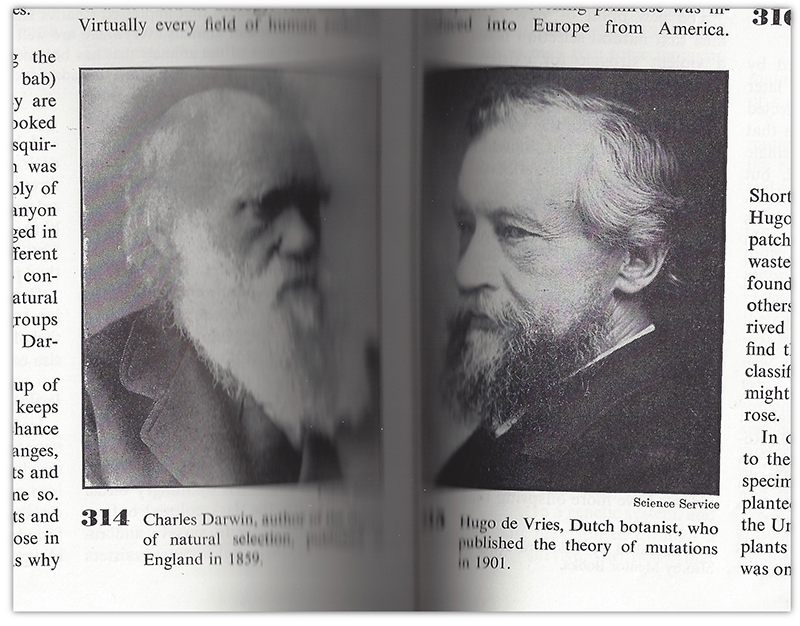December 14, 2013
[NOTE: This post has been significantly revised – and improved – based on input from Jim Endersby, author of the Isis article referenced herein. The original post, along with Endersby’s comments and my reply, are attached as an addendum.]
Dutch botanist Hugo de Vries gained global fame in the first decades of the twentieth century for being the guy who finally figured out how evolution worked.

Opposing portraits of Charles Darwin and Hugo de Vries from the 1954 edition of Ella Thea Smith’s popular high school textbook, Exploring Biology.
Of course today we credit Darwin for this discovery, and backdate it to the publication of Origin of Species in 1859. But for many decades, into the 1930s in fact, Darwin’s theory of natural selection was considered insufficient (see Bowler, 1992). In the minds of many, De Vries’ idea completed the story of evolution.
MUTATION THEORY
Rather than suggesting that speciation resulted from an accumulation of small variations over long periods of time, like Darwin’s theory implied, De Vries posited that new species could actually pop into existence in a single generation. In fact, according to De Vries, multiple representatives of the same new species could pop simultaneously, creating a pool that would breed true.
Many biologists felt De Vries had solved the most vexing problem in evolution – how variations could avoid being swamped or blended back to average through interbreeding.
Yes, he was a self-promoter, but De Vries wasn’t just making stuff up. He was a respected experimentalist, and had evidence to support his idea. In fact, he was one of the guys credited for the rediscovery of Mendelian genetics. Unfortunately, the object of De Vries’ research, Oenothera lamarckiana, the evening primrose, proved a little too good to be true. Shortly after De Vries announced his findings, Oenothera was found to be a polyploid, an organism with more than two complete sets of chromosomes. What looked like spontaneous speciation turned out to be an interesting but expected result of a complex biology.
Scientists moved on to observations of less problematic organisms, like Drosophila.
But, despite concerns from specialists, the public remained fascinated with De Vries. The possibility of rapid evolution, which held the promise of rapid and conscious improvement in plants and animals, was catnip in the Progressive Era. De Vries mutation theory dovetailed nicely with Luther Burbank’s hybridization experiments. Together, they created a package that promised better living through science.
And, frankly, professional scientists had nothing better to offer.
Critiquing De Vries, Stanford’s David Starr Jordan and Vernon Lyman Kellogg, in Evolution and Animal Life (1916), wrote:
At the present moment, probably because of a strong reaction against the too blind acceptance and general over-emphasis of the selection doctrines, and because, too, of the unusually extensive character of De Vries’s experimentation and observation, and his trenchant criticism of the weak places in the other theories, with the generally weighty character of his work and reputation, because of all this the theory of species-forming by mutations has at the present moment a fairly large body of adherents among reputable biologists (115).
But, as Jordan and Kellogg admitted, they couldn’t counter with much. While they were quick to point out the meagerness of evidence in support of De Vries’ ideas, they also noted the meagerness of evidence in support of “direct species-forming” by natural selection, or any of the other theories purporting to explain evolution then in common circulation.
In his recent article, “Mutant Utopias: Evening Primroses and Imagined Futures in Early Twentieth-Century America” (Isis, September 2013), Jim Endersby, an historian at the University of Sussex, revives the story of De Vries, and suggests it serves as a good example of just how critical it is to examine the history of science as a social product. Because of its general popularity and play in the press, according to Endersby, De Vries’ mutation theory, even after it became scientifically suspect, had a major influence on how biologists imagined and talked about their role in society, and even what constituted “legitimate science.”
A story after my own heart, with a history perhaps even more interesting than Endersby suggests.
WHAT DO BIOLOGY TEXTBOOKS TELL US?
Textbooks, because they are published and revised almost annually, allow us to date the introduction, development and (sometimes) demise of ideas over time. Twentieth century high school and college biology textbooks present an excellent record of the history and use of De Vries’ ideas.
What we see when we look at the textbook evidence is that Endersby has the early history right. Though mutation theory, proper, never gained much play, De Vries was introduced without disclaimer in very early textbooks, including those of George W. Hunter, Essentials of Biology (1911) and Civic Biology (1914). However, again as Endersby relates, within a few years, textbook authors knew there were problems with De Vries’ data, and started working to challenge popular misconceptions.
Clifton Hodge and Jean Dawson in their 1918 Civic Biology (not to be confused with Hunter’s Civic Biology) pointed out the problemnatic complex biology of De Vries test organism. They wrote, “It now turns out that … Oenthera lamarckiana is a Mendelian cross, a hybrid; and this suggests that all mutations may be merely cases of segregation and recombination of unit characters in the germs of plants and animals” (338).
After Thomas Hunt Morgan began publishing more securely evidenced work on the function of genes around 1915, professional attention swung back to incrementalism. However, though mutation quickly stopped meaning all-at-once speciation, somewhat contrary to Endersby’s suggestion, De Vries didn’t go away. In fact, his reputation grew steadily, at least in textbooks, as scientists zeroed in on genetic mutations as the raw material upon which natural selection acts.
In textbooks in the latter 20s, De Vries was hard-linked to Hermann J. Muller, a student of Morgan’s, and a scientist who himself gained a fair amount of public acclaim for demonstrating how mutations could be “accelerated” using X-rays.
In 1931, Henry R. Barrows in College Biology, referencing both De Vries and Muller’s work, confidently wrote, “It is fairly well established that mutations are responsible for the origin of species” (275).
From the 1930s into the 1950s, De Vries, along with Lamarck and Darwin, became the backbone of the origin story of modern evolutionary theory. It was simple. Lamarck thought it up. Darwin made it science. And De Vries made it work.
A terribly simplified story, for sure. But in the better textbooks, including Ella Thea Smith’s high school text, Exploring Biology and George Gaylord Simpson’s college text, Life, the Lamarck, Darwin, De Vries lineup served to introduce Thomas Hunt Morgan’s genetics, Hermann J. Muller’s X-ray experiments and the collective consensus we now call the modern synthesis.
While the always execrable Modern Biology (Moon et al.) promoted De Vries’ mutation theory in its original form through the end of the 1960s (see related article), the better authors got it right, more or less right away. They credited De Vries for the general concept of mutation while simultaneously deflating whatever misconceptions the popular press may have been pumping.
And there is very good evidence that the Lamarck, Darwin, De Vries origin story was completely acceptable to specialists within the field.
Sometime in 1956, Harcourt sent George Gaylord Simpson, one of the fathers of the modern synthesis, a review copy of the 1954 edition of Smith’s Exploring Biology, presumably in preparation for the text’s later revision. In a tight scribble on the back of 7 sheets of American Museum of Natural History letterhead, Simpson provided a page-by-page critique of Smith’s work. Simpson was a famously cranky man, and it comes through in his notes. However, nowhere in the notes is there mention of Smith’s use of De Vries as a way to introduce students to the synthesis. In fact, Simpson himself would deploy De Vries similarly in Life, published the following year.
SO WHERE DID HUGO GO?
In 1963, a professional association called the Biological Sciences Curriculum Study (BSCS), finishing four years of work, directed the publication of three new high school textbooks. These textbooks set out a new origin story. Gone was De Vries, and his “wrong-headed” notion of all-at-once mutation. In his place, picking up from Simpson’s text, the BSCS authors identified an American cytologist named Walter Sutton as the genesis point. Sutton, then, passed the torch to T. H. Morgan. Morgan, through his student, Hermann J. Muller, then carried the news to the biologists who formulated the modern synthesis.
Very neat and clean.
While Simpson was kind enough to give De Vries a footnote, the BSCS authors erased him altogether.
I’ve argued elsewhere that Muller, as a member of the BSCS steering committee, used the platform to try and reverse a slide in public affection for directed evolution (aka eugenics), an idea that had slowly, but progressively through the 1950s, become indefensible as the lessons of Nazism sunk in. Muller was unreconstructed. He disliked the ecological direction biology had taken (see related article), I think because it suggested evolution wasn’t progressive. In fact, the BSCS text he most influenced, the “yellow version,” directed by John A. Moore and Bentley Glass, which directly linked organic evolution and cultural evolution, is probably the most unabashedly progressionist textbook published in the post-eugenics era.
Perhaps too, through the BSCS, Muller saw the chance to cut himself free from De Vries, with whom he had been coupled for thirty five years, probably quite unhappily.
But even if Muller’s influence was minor, and the BSCS authors’ motivations more prosaic, the texts the group developed did whitewash, or at least clean up, the generally messy history of twentieth-century genetics and evolutionary theory.
Endersby wonders, “why historians have hitherto not generally given [mutation theory] the attention it warrants.” Seeing how antievolutionary writers around the time of the Scopes trial appropriated the theory, Endersby speculates that contemporary historians may be reluctant to provide further “ammunition to the enemies of science.” More central to his thesis, however, Endersby suggests that De Vries has been ignored because historians of science remain “fixated on scientists’ ideas and their work.” Since De Vries mutation theory doesn’t fit neatly on the path to the modern synthesis, it’s not much worth noting. Mutant Utopias is fundamentally an argument for expanding historical analysis of the history of scientific ideas to include factors external to the work of specialists.
I certainly won’t argue with that.
However, I do wonder if historians of science have avoided exploring the impact De Vries had on the history of the idea of evolution out of fear of giving aid and comfort to creationists. Coming at the absolute nadir of creationism in the United States, its unlikely scientists in the early 1960s buried De Vries in order to inoculate themselves from the critique of antievolutionary writers. Even if the intent of the BSCS was to simply open up space – a De Vries-free zone – for the modern synthesis to flourish, Smith’s work shows that the effort was hardly necessary.
I think a more likely reason why De Vries has been ignored is that historians of science have been a little too quick to accept the history of the theory of evolution as told by scientists who developed the “winning theory.” The origin story to which we now too commonly subscribe, the one that does not include Hugo De Vries, was a constriction (much like the synthesis itself was a constriction) in what qualified as a legitimate avenue of inquiry.
It’s a story that was written, not in the 1920s, but in the latter 1950s and early 1960s, at the height of the Cold War, at the transition from brutal eugenics to subtle population management, and, perhaps most importantly, after the last promoters of ideas-that-were-not-the-modern-synthesis were no longer around to complicate things.
ADDENDUM
Where’d Hugo Go (Original 12-11-13)
Where’s Hugo Go (Original 12-11-13) Comment and Reply

2 Comments